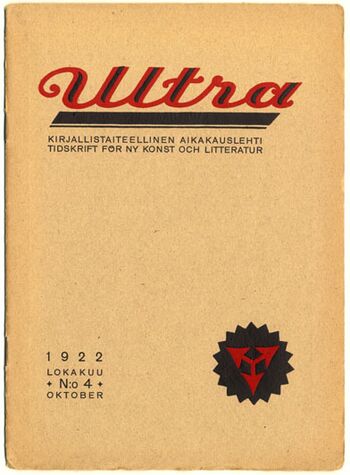Difference between revisions of "Ultra"
m (Text replacement - "258px" to "350px") |
|||
| (4 intermediate revisions by the same user not shown) | |||
| Line 1: | Line 1: | ||
| − | [[Image:Ultra_4_1922.jpg|thumb| | + | [[Image:Ultra_4_1922.jpg|thumb|350px|Cover of ''Ultra'' 4, 1922.]] |
| − | '''Ultra: tidskrift för ny konst och litteratur''' [Magazine for New Art and Literature] was published bilingually in Finnish and Swedish in 8 issues in Helsinki between September and December 1922. | + | '''Ultra: kirjallistaiteellinen aikakauslehti: tidskrift för ny konst och litteratur''' [Magazine for New Art and Literature] was published bilingually in Finnish and Swedish in 8 numbers (7 issues) in Helsinki between September and December 1922. The magazine was edited by the Finnish writer and dramatist [[Lauri Haarla]], the Finland-Swedish critic [[Haggar Olsson]] and the Finland-Swedish film and theatre critic [[Raoul af Hällström]]. The contributors included T.K. Sallinnen, Ludwig Meidner, Kathe Kollwitz and Ester Heleniu. ''Ultra'' was tied to the small publishing house Daimon, run by L. A. Salava, a dealer in antiquarian books. |
| + | |||
| + | ==Issues== | ||
| + | * [http://bluemountain.princeton.edu/exist/apps/bluemountain/title.html?titleURN=bmtnabn Scans in Blue Mountain Project] | ||
==Literature== | ==Literature== | ||
| Line 9: | Line 12: | ||
* [[Sweden#Avant-garde]] | * [[Sweden#Avant-garde]] | ||
| − | == | + | ==Links== |
| − | |||
* [http://fi.wikipedia.org/wiki/Ultra_(1922) Ultra at Finnish Wikipedia] | * [http://fi.wikipedia.org/wiki/Ultra_(1922) Ultra at Finnish Wikipedia] | ||
{{Avant-garde and modernist magazines}} | {{Avant-garde and modernist magazines}} | ||
Latest revision as of 23:00, 25 May 2022
Ultra: kirjallistaiteellinen aikakauslehti: tidskrift för ny konst och litteratur [Magazine for New Art and Literature] was published bilingually in Finnish and Swedish in 8 numbers (7 issues) in Helsinki between September and December 1922. The magazine was edited by the Finnish writer and dramatist Lauri Haarla, the Finland-Swedish critic Haggar Olsson and the Finland-Swedish film and theatre critic Raoul af Hällström. The contributors included T.K. Sallinnen, Ludwig Meidner, Kathe Kollwitz and Ester Heleniu. Ultra was tied to the small publishing house Daimon, run by L. A. Salava, a dealer in antiquarian books.
Contents
Issues[edit]
Literature[edit]
- Mats Jansson, "Crossing Borders: Modernism in Sweden and the Swedish-Speaking Part of Finland: Thalia (1909-13); Ny konst (1915); flamman (1917-21); Ultra (1922); Quosego (1928-9); kontakt (1931); Spektrum (1931-3); and Karavan (1934-5)", in The Oxford Critical and Cultural History of Modernist Magazines, Vol. 3 (Europe, 1880-1940), New York: Oxford University Press, 2013, pp 666-690. [1]
See also[edit]
Links[edit]
| Avant-garde and modernist magazines | ||
|---|---|---|
|
Poesia (1905-09, 1920), Der Sturm (1910-32), Blast (1914-15), The Egoist (1914-19), The Little Review (1914-29), 291 (1915-16), MA (1916-25), De Stijl (1917-20, 1921-32), Dada (1917-21), Noi (1917-25), 391 (1917-24), Zenit (1921-26), Broom (1921-24), Veshch/Gegenstand/Objet (1922), Die Form (1922, 1925-35), Contimporanul (1922-32), Secession (1922-24), Klaxon (1922-23), Merz (1923-32), LEF (1923-25), G (1923-26), Irradiador (1923), Sovremennaya architektura (1926-30), Novyi LEF (1927-29), ReD (1927-31), Close Up (1927-33), transition (1927-38). | ||
| Full list | ||
|---|---|---|
|
Entretiens politiques et littéraires (1890-93), Moderní revue (1894-1925), Volné směry (1897-1948), Mir iskusstva (1898-1904), Vesy (1904-09), Poesia (1905-09, 1920), Zolotoe runo (1906-10), The Mask (1908-29), Apollon (1909-17), Ukraïnska khata (1909-14), Der Sturm (1910-32), Thalia (1910-13), Rhythm (1911-13), Trudy i dni (1912), Simbolul (1912), The Glebe (1913-14), Ocharovannyi strannik (1913-16), Revolution (1913), Blast (1914-15), The Little Review (1914-29), Futuristy (1914), Zeit-Echo (1914-17), The Egoist (1914-19), L'Élan (1915-16), 291 (1915-16), Orpheu (1915), La Balza futurista (1915), MA (1916-25), SIC (1916-19), flamman (1916-21), The Blindman (1917), Nord-Sud (1917-18), De Stijl (1917-20, 1921-32), Dada (1917-21), Klingen (1917-20, 1942), Noi (1917-25), 391 (1917-24), Modernisme et compréhension (1917), Anarkhiia (1917-18), Iskusstvo kommuny (1918-19), Formiści (1919-21), S4N (1919-25), La Cité (1919-35), Aujourd'hui (1919), Exlex (1919-20), L'Esprit nouveau (1920-25), Orfeus (1920-21), Action (1920-22), Proverbe (1920-22), Ça ira (1920-23), Zenit (1921-26), Kinofon (1921-22), Het Overzicht (1921-25), Jednodńuwka futurystuw (1921), Nowa sztuka (1921-22), Broom (1921-24), Život (1921-48), Creación (1921-24), Jar-Ptitza (1921-26), New York Dada (1921), Aventure (1921-22), Spolokhi (1921-23), Gargoyle (1921-22), Veshch/Gegenstand/Objet (1922), Kino-fot (1922-23), Le Coeur à barbe (1922), Die Form (1922, 1925-35), 7 Arts (1922-28), Manomètre (1922-28), Ultra (1922), Út (1922-25), Dada-Jok (1922), Dada Tank (1922), Dada Jazz (1922), Mécano (1922-23), Contimporanul (1922-32), Zwrotnica (1922-23, 1926-27), Secession (1922-24), Stavba (1922-38), Gostinitsa dlya puteshestvuyuschih v prekrasnom (1922-24), Putevi (1922-24), Klaxon (1922-23), Akasztott Ember (1922-23), MSS (1922-23), Perevoz Dada (1922-49), Egység (1922-24), L'Architecture vivante (1923-33), Merz (1923-32), LEF (1923-25), G (1923-26), The Next Call (1923-26), Russkoye iskusstvo (1923), Disk (1923-25), Irradiador (1923), Surréalisme (1924), Almanach Nowej Sztuki (1924-25), La Révolution surréaliste (1924-29), Blok (1924-26), Pásmo (1924-26), DAV (1924-37), Bulletin de l'Effort moderne (1924-27), ABC (1924-28), CAP (1924-28), Athena (1924-25), Punct (1924-25), 75HP (1924), Le Tour de Babel (1925), Periszkop (1925-26), Integral (1925-28), Praesens (1926, 1930), Sovremennaya architektura (1926-30), bauhaus (1926-31), Das neue Frankfurt (1926-31), L'Art cinématographique (1926-31), Dokumentum (1926-27), Kritisk Revy (1926-28), Novyi LEF (1927-29), i 10 (1927-29), Nova generatsiia (1927-30), ReD (1927-31), Dźwignia (1927-28), Tank (1927-28), Close Up (1927-33), Horizont (1927-32), transition (1927-38), Discontinuité (1928), Munka (1928-39), Quosego (1928-29), Urmuz (1928), Unu (1928-32), Revista de Antropofagia (1928-29), 50 u Evropi (1928-29), Documents (1929-30), L'Art Contemporain - Sztuka Współczesna (1929-30), Adam (1929-40), Art concret (1930), Zvěrokruh (1930), Alge (1930-31), Le Surréalisme au service de la révolution (1930-33), Levá fronta (1930-33), Kvart (1930-37, 1945-49), Nová Bratislava (1931-32), Linja (1931-33), Spektrum (1931-33), Nadrealizam danas i ovde (1931-32), Ulise (1932-33), Die neue Stadt (1932-33), Mouvement (1933), PLAN (1933-36), Karavan (1934-35), Ekran (1934), Axis (1935-37), Acéphale (1936-39), Telehor (1936), aka (1937-38), Plastique (1937-39), Plus (1938-39), Les Réverbères (1938-39). | ||
